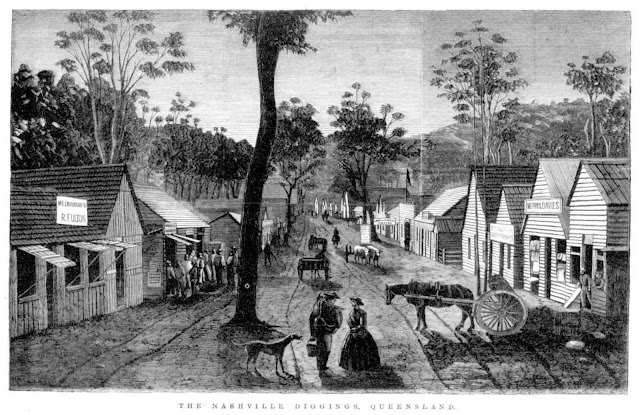GYMPIE GOLDFIELDS
The report of the discovery of payable gold in a gully running into the Mary River was made to the Government officials on the 16th of October, 1867, the lucky prospector having been Mr. James Nash, who was fossicking about the creeks and gullies for a means of living. Just at this period, there was great financial depression all over Queensland, and the news of the finding of alluvial gold in large quantities spread all over Australia. A most determined rush took place. The first miners' rights issued on the gold-field were dated 28th of October, 1867, and between that date and the 27th of March, 1868, the total of miners' rights issued on the field reached 4256. A miner named Robinson pegged off the first claim, and colours of gold were obtained in nearly all the creeks and gullies within a radius of 50 miles around the office of the Commissioner (Mr. H. E. King), at Nashville, the site of the first claim having been christened "Quiet Corner Gully," Nashville.
Miners continued to pour in to Nashville from all parts of Queensland, owing to the continued reported finds of nuggets of gold, and many residents of Ipswich and the surrounding districts "humped their bluey" to the newly-discovered gold area. Indeed, Ipswich was almost deserted. Many of the city's business people flocked to Nashville.
In January of 1868 the proprietors of the "Queensland Times" (Messrs. Parkinson, Sloman, and Kidner), purchasing the plant of the "Ipswich Mercury," published in Lower Ellenborough street, by the late Mr. J. B. Southern, determined to convoy the printing machinery, etc., to the scene of the new gold-field, and in due course the first issue of "The Nashville Times and Mary River Mining Gazette" (published by F. Kidner and Co.) appeared on the 15th of February, 1868. All hands were former employees of the "Queensland Times," with Mr. Hugh Parkinson in charge. The staff comprised Messrs. H. Rodgers (reporter), James Chapple, John Feeney, Con. Galloway, and James Irwin (a brother of the late Mr. Samuel Irwin, of the Warwick "Examiner"). The "Nashville Times" was subsequently changed to "Gympie Times."
Ipswich people not only established the first newspaper in Gympie, but several installed the first quartz-crushing machine, which was erected by Messrs Pye, Bachelor and Co., and was known as the Pioneer Quartz-crushing Company. Its first crushing was a big success, some 817 ozs, of pure gold having been obtained from 6cwt of stone. The name of the machine was "Hector."
On the 6th of February, 1868, a further fillip was given to the Nashville gold-field by the unearthing, by a miner named George Curtis, of a huge nugget of gold weighing 1040 ozs. This lump of precious meal was called "The Perseverance Nugget." That discovery made Gympie. During the 60 years following the quantity of gold won from those fields was aggregated 3,800,000 ozs., and valued at £14,000,000.
Sources:
- Gympie Goldfields (1917, October 17). Warwick Examiner and Times (Qld. : 1867 - 1919), p. 4.
- The Nashville Diggings, Queensland (1868, July 11). Illustrated Australian News for Home Readers (Melbourne, Vic. : 1867 - 1875), p. 4.







No comments